If it wasn’t so serious, the lies and dissimulation of the US and European Governments over Syria would be amusing.
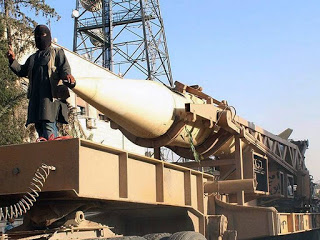 |
| ISIS rocket paraded in Rakah |
Having admitted only a couple of weeks ago that there were no ‘moderates’ in the opposition to Assad, those they’d been training had either been wiped out by Al-Nusra or capitulated, we have now seen their miraculous resurrection. As Robert Fisk has pointed out this is all smoke and mirrors. Syria’s ‘Moderates’ Have Disappeared… and There Are No Good Guys http://www.azvsas.blogspot.co.uk/2015/10/syria-choice-is-between-bad-and-far.html
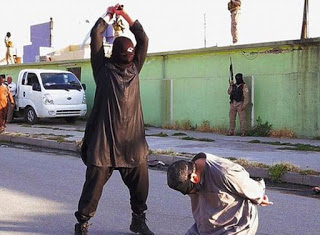 |
| Doing it the Saudi way – murder in Palmyra |
What is and has been happening is that the US and its allies created Isis, have lied through their teeth about where their funding has come from (almost certainly not from large oil transactions) which is Saudi and Gulf money, have been backing al-Nusra the al Qaeda affiliate (now a ‘moderate’ terrorist group!) all in the name of perpetuating the carnage in Syria and permanently destabilising it. Israel’s open support for Al Nusra is just one aspect of this.
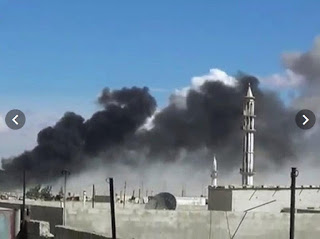 |
| aftermath of American bombing |
The Russian’s attack on Isis and friends have their thrown NATO into panic. A 2 minute accidental incursion into Turkey by Russian planes is a major incident, unlike the Turkish bombing of Kurdish PKK bases in Iraq. That of course is perfectly permissible as is the use of Turkey as a rear base for Isis.
Tony Greenstein
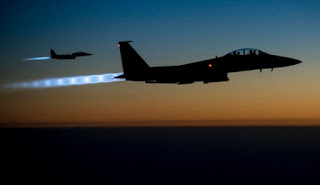 |
| US aircraft over Iraq |
By
Gareth Porter
Gareth Porter
October
08, 2015
08, 2015
Pundits and
politicians are already looking for a convenient explanation for the twin
Middle East disasters of the rise of Islamic State and the humanitarian
catastrophe in Syria. The genuine answer is politically unpalatable, because
the primary cause of both calamities is U.S. war and covert operations in the
Middle East, followed by the abdication of U.S. power and responsibility for
Syria policy to Saudi Arabia and other Sunni allies.
politicians are already looking for a convenient explanation for the twin
Middle East disasters of the rise of Islamic State and the humanitarian
catastrophe in Syria. The genuine answer is politically unpalatable, because
the primary cause of both calamities is U.S. war and covert operations in the
Middle East, followed by the abdication of U.S. power and responsibility for
Syria policy to Saudi Arabia and other Sunni allies.
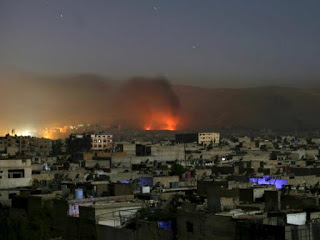 |
| Russian bombing in Syria |
The emergence of a
new state always involves a complex of factors. But over the past three
decades, U.S. covert operations and war have entered repeatedly and powerfully
into the chain of causality leading to Islamic State’s present position.
new state always involves a complex of factors. But over the past three
decades, U.S. covert operations and war have entered repeatedly and powerfully
into the chain of causality leading to Islamic State’s present position.
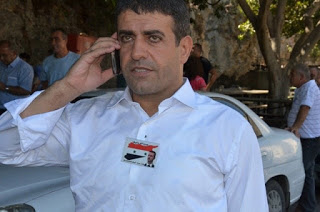 |
| Sedki al-Maket, an Israeli Druze arrested-under-gag for blowing the whistle on Israeli support for al-Nusra |
The causal chain
begins with the role of the U.S. in creating a mujahedeen force to fight the
Soviets in Afghanistan in the 1980s. Osama bin Laden was a key facilitator in
training that force in Afghanistan. Without that reckless U.S. policy, the
blowback of the later creation of al-Qaida would very likely not have occurred.
But it was the U.S. invasion and occupation of Iraq that made al-Qaida a
significant political-military force for the first time. The war drew Islamists
to Iraq from all over the Middle East, and their war of terrorism against Iraqi
Shiites was a precursor to the sectarian wars to follow.
begins with the role of the U.S. in creating a mujahedeen force to fight the
Soviets in Afghanistan in the 1980s. Osama bin Laden was a key facilitator in
training that force in Afghanistan. Without that reckless U.S. policy, the
blowback of the later creation of al-Qaida would very likely not have occurred.
But it was the U.S. invasion and occupation of Iraq that made al-Qaida a
significant political-military force for the first time. The war drew Islamists
to Iraq from all over the Middle East, and their war of terrorism against Iraqi
Shiites was a precursor to the sectarian wars to follow.
The actual creation
of Islamic State is also directly linked to the Iraq War. The former U.S.
commander at Camp Bucca in Iraq has
acknowledged that the detention of 24,000 prisoners, including
hard-core al-Qaida cadres, Baathist officers and innocent civilians, created a
“pressure cooker for extremism.” It was during their confinement in that camp
during the U.S. troop surge in Iraq 2007 and 2008 that nine senior al-Qaida
military cadres planned
the details of how they would create Islamic State.
of Islamic State is also directly linked to the Iraq War. The former U.S.
commander at Camp Bucca in Iraq has
acknowledged that the detention of 24,000 prisoners, including
hard-core al-Qaida cadres, Baathist officers and innocent civilians, created a
“pressure cooker for extremism.” It was during their confinement in that camp
during the U.S. troop surge in Iraq 2007 and 2008 that nine senior al-Qaida
military cadres planned
the details of how they would create Islamic State.
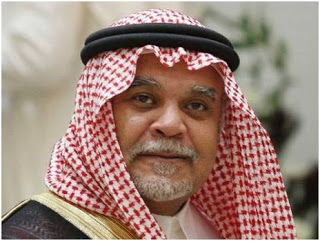 |
| Prince Bandar bin Sultan – powerful ex-Saudi ambassador to the US |
The Obama
administration completed the causal chain by giving the green light to a major
war in Syria waged by well-armed and well-trained foreign jihadists. Although
the Assad regime undoubtedly responded to the firebombing of the Baath Party
headquarters in Daraa in mid-March 2011 with excessive force, an armed struggle
against the regime began almost immediately. In late March or early April, a
well-planned ambush of Syrian troops killed at least two dozen soldiers near
the same city. Other killings of troops took place in April in other cities,
including Daraa, where 19 soldiers were gunned down.
administration completed the causal chain by giving the green light to a major
war in Syria waged by well-armed and well-trained foreign jihadists. Although
the Assad regime undoubtedly responded to the firebombing of the Baath Party
headquarters in Daraa in mid-March 2011 with excessive force, an armed struggle
against the regime began almost immediately. In late March or early April, a
well-planned ambush of Syrian troops killed at least two dozen soldiers near
the same city. Other killings of troops took place in April in other cities,
including Daraa, where 19 soldiers were gunned down.
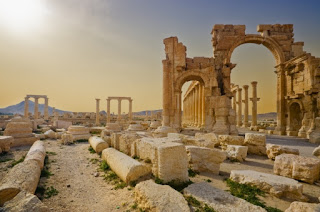 |
| Palmura before ISIS destroyed its heritage |
During the second
half of 2011 and through 2012, thousands of foreign jihadists streamed into
Syria. As early
as November 2011, al-Qaida was playing a central role in the war,
carrying out spectacular suicide bombings in Damascus and Aleppo. Obama should
have reacted to the first indications of that development and insisted that
Turkey, Saudi Arabia and Qatar keep external arms and military personnel and
funding out of Syria in order to allow a process of peaceful change to take
place. Instead, however, the administration became an integral part of a proxy
war for regime change.
half of 2011 and through 2012, thousands of foreign jihadists streamed into
Syria. As early
as November 2011, al-Qaida was playing a central role in the war,
carrying out spectacular suicide bombings in Damascus and Aleppo. Obama should
have reacted to the first indications of that development and insisted that
Turkey, Saudi Arabia and Qatar keep external arms and military personnel and
funding out of Syria in order to allow a process of peaceful change to take
place. Instead, however, the administration became an integral part of a proxy
war for regime change.
Seymour Hersh reported
last year that an unpublished addendum to the Senate Intelligence
Committee report on Benghazi revealed a covert CIA operation to arm Syrian
rebels, in cooperation with Sunni allies’ intelligence services. In early 2012,
Hersh reported, following an agreement with Turkey, then-CIA Director David
Petraeus approved an elaborate covert operation in which Turkey, Saudi Arabia
and Qatar would fund the shipment of weapons to Syrian rebels from stocks
captured from the Gadhafi government. The scheme employed front companies set
up in Libya to manage the shipments of arms in order to separate the U.S.
government from the operation. An October 2012 Defense Intelligence Agency
report released by the Department of Defense to Judicial Watch confirmed
the shipments of Libyan weapons from the port of Benghazi to two Syrian ports
near Turkey beginning in October 2011 and continuing through August 2012.
last year that an unpublished addendum to the Senate Intelligence
Committee report on Benghazi revealed a covert CIA operation to arm Syrian
rebels, in cooperation with Sunni allies’ intelligence services. In early 2012,
Hersh reported, following an agreement with Turkey, then-CIA Director David
Petraeus approved an elaborate covert operation in which Turkey, Saudi Arabia
and Qatar would fund the shipment of weapons to Syrian rebels from stocks
captured from the Gadhafi government. The scheme employed front companies set
up in Libya to manage the shipments of arms in order to separate the U.S.
government from the operation. An October 2012 Defense Intelligence Agency
report released by the Department of Defense to Judicial Watch confirmed
the shipments of Libyan weapons from the port of Benghazi to two Syrian ports
near Turkey beginning in October 2011 and continuing through August 2012.
A larger covert
program involved a joint military operations center in Istanbul, where CIA
officers worked with Turkish, Saudi and Qatari intelligence agencies that were
also providing arms to their favorite Syrian rebels groups, according to
sources who talked
with The Washington Post’s David Ignatius.
program involved a joint military operations center in Istanbul, where CIA
officers worked with Turkish, Saudi and Qatari intelligence agencies that were
also providing arms to their favorite Syrian rebels groups, according to
sources who talked
with The Washington Post’s David Ignatius.
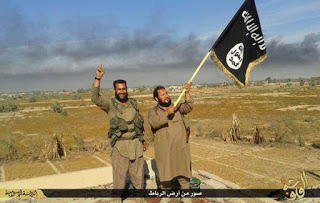 |
| Isis waves the flag |
By November 2012,
al-Qaida’s Syrian franchise, al-Nusra Front, had 6,000 to 10,000 troops—mostly
foreign fighters—under its command and was regarded as the most
disciplined and effective fighting force in the field. The CIA’s
Gulf allies armed brigades that had allied themselves with al-Nusra—or were
ready to do so. A Qatari intelligence officer is said to have declared, “I will
send weapons to al-Qaeda if it will help” topple Assad.
al-Qaida’s Syrian franchise, al-Nusra Front, had 6,000 to 10,000 troops—mostly
foreign fighters—under its command and was regarded as the most
disciplined and effective fighting force in the field. The CIA’s
Gulf allies armed brigades that had allied themselves with al-Nusra—or were
ready to do so. A Qatari intelligence officer is said to have declared, “I will
send weapons to al-Qaeda if it will help” topple Assad.
The CIA officials
overseeing the covert operation knew very well what their Sunni allies were
doing. After the U.S. shipments from Benghazi stopped in September 2012 because
of the attack on the U.S. diplomatic post there, a CIA
analysis reminded President Obama that the covert operation in
Afghanistan had ended up creating a Frankenstein monster. Even the now-famous
account in Hillary Clinton’s 2014 memoirs about Obama rejecting a proposal in
late 2012 from CIA Director Petraeus for arming and training Syrian rebels does
not hide the fact that everyone was well aware of the danger that arms sent to
“moderates” would end up in the hands of terrorists.
overseeing the covert operation knew very well what their Sunni allies were
doing. After the U.S. shipments from Benghazi stopped in September 2012 because
of the attack on the U.S. diplomatic post there, a CIA
analysis reminded President Obama that the covert operation in
Afghanistan had ended up creating a Frankenstein monster. Even the now-famous
account in Hillary Clinton’s 2014 memoirs about Obama rejecting a proposal in
late 2012 from CIA Director Petraeus for arming and training Syrian rebels does
not hide the fact that everyone was well aware of the danger that arms sent to
“moderates” would end up in the hands of terrorists.
Despite this, after
rejecting Petraeus’ plan in 2012, Obama approved
the covert training of “moderate” Syrian rebels in April 2013. As
the Pentagon has been forced to acknowledge in recent weeks, that program has
been a complete fiasco, as the units either joined al-Nusra or were attacked by
al-Nusra. Meanwhile, as Vice President Joe
Biden pointed out in October 2014, Turkey, Saudi Arabia and the
United Arab Emirates were pouring “hundreds of millions of dollars and tens,
thousands of tons of weapons” into Syria that were ending up in the hands of
the jihadists.
rejecting Petraeus’ plan in 2012, Obama approved
the covert training of “moderate” Syrian rebels in April 2013. As
the Pentagon has been forced to acknowledge in recent weeks, that program has
been a complete fiasco, as the units either joined al-Nusra or were attacked by
al-Nusra. Meanwhile, as Vice President Joe
Biden pointed out in October 2014, Turkey, Saudi Arabia and the
United Arab Emirates were pouring “hundreds of millions of dollars and tens,
thousands of tons of weapons” into Syria that were ending up in the hands of
the jihadists.
Unfortunately,
Biden’s complaint came two and a half years too late. By October 2014, more
than 15,000 foreign fighters, including 2,000 Westerners, were
estimated to have gone to Syria. Islamic State and al-Nusra Front
emerged as the two major contenders for power in Syria once Assad is
overthrown, and the Saudis and Qataris were now ready to place their bets on
al-Nusra. In early 2015, after King Salman inherited the Saudi throne, the
three Sunni states began focusing their support on al-Nusra and its military
allies, encouraging them to form a new military command, the “Army of
Conquest.” The al-Nusra-led front then captured Idlib province in March.
Biden’s complaint came two and a half years too late. By October 2014, more
than 15,000 foreign fighters, including 2,000 Westerners, were
estimated to have gone to Syria. Islamic State and al-Nusra Front
emerged as the two major contenders for power in Syria once Assad is
overthrown, and the Saudis and Qataris were now ready to place their bets on
al-Nusra. In early 2015, after King Salman inherited the Saudi throne, the
three Sunni states began focusing their support on al-Nusra and its military
allies, encouraging them to form a new military command, the “Army of
Conquest.” The al-Nusra-led front then captured Idlib province in March.
Obama, focusing on
the Iran nuclear agreement, has given no indication that he is troubled by his
allies’ approach. If the Bush administration destabilized Iraq in order to
increase U.S. military presence and power in the Middle East, the Obama
administration has countenanced a proxy war that has destabilized and Syria
because of his primary concern with consolidating the U.S. alliances with the
Saudis and the other Sunni regimes.
the Iran nuclear agreement, has given no indication that he is troubled by his
allies’ approach. If the Bush administration destabilized Iraq in order to
increase U.S. military presence and power in the Middle East, the Obama
administration has countenanced a proxy war that has destabilized and Syria
because of his primary concern with consolidating the U.S. alliances with the
Saudis and the other Sunni regimes.
Although it has been
almost a rigid rule that pundits must ascribe U.S. fealty to its Saudi alliance
to oil interests, oil is far from the top of the list of U.S interests today.
More important to our national security state is the interest of the Pentagon
and the military services to protect the military bases they have in Turkey,
Saudi Arabia, Bahrain, Qatar, Kuwait and the UAE. Their need to preserve those
alliance relationships is intensified by the Gulf Cooperation Council (GCC)
cornucopia of military contracts for U.S. arms manufacturers that assures
enormous profits will continue to flow for the foreseeable future. One
estimate of the total at stake for the Pentagon and its private
allies in military relationships with the GCC is $100 billion to $150 billion
over two decades.
almost a rigid rule that pundits must ascribe U.S. fealty to its Saudi alliance
to oil interests, oil is far from the top of the list of U.S interests today.
More important to our national security state is the interest of the Pentagon
and the military services to protect the military bases they have in Turkey,
Saudi Arabia, Bahrain, Qatar, Kuwait and the UAE. Their need to preserve those
alliance relationships is intensified by the Gulf Cooperation Council (GCC)
cornucopia of military contracts for U.S. arms manufacturers that assures
enormous profits will continue to flow for the foreseeable future. One
estimate of the total at stake for the Pentagon and its private
allies in military relationships with the GCC is $100 billion to $150 billion
over two decades.
Those are crucial
bureaucratic and business stakes for the U.S. national security state, which is
usually driven by the bottom lines associated with different courses of action.
Especially given the administration’s lack of a coherent geopolitical perspective
on the region, the security state’s interests offer a persuasive explanation
for Obama’s effectively farming out the most important element of its Syria
policy to regional allies, with disastrous results.
bureaucratic and business stakes for the U.S. national security state, which is
usually driven by the bottom lines associated with different courses of action.
Especially given the administration’s lack of a coherent geopolitical perspective
on the region, the security state’s interests offer a persuasive explanation
for Obama’s effectively farming out the most important element of its Syria
policy to regional allies, with disastrous results.
Gareth Porter is an
independent investigative journalist and winner of the 2012 Gellhorn Prize for
journalism. He is the author of the newly published Manufactured
Crisis: The Untold Story of the Iran Nuclear Scare.
independent investigative journalist and winner of the 2012 Gellhorn Prize for
journalism. He is the author of the newly published Manufactured
Crisis: The Untold Story of the Iran Nuclear Scare.
Posted in Blog